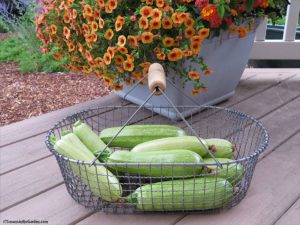May 14 Column: Postage Stamp Garden

My garden column this week is all about growing a postage stamp garden. What? You’ve never heard of one before? Well, I’m talking about a very small — but productive — vegetable garden that just about everyone should have room for and time to tend. Here’s a link to my column in today’s edition of The Spokesman-Review: Even a small spot can yield big and tasty results. (or you can read my column lower in this post)
When our house was being built many years ago, it was during gardening season. I just hated the thought of not being able to grow some veggies that year. We had sold our old house and were renting a house for the summer. Our nice landlady said I was welcome to plant a small garden. I grew a tiny one that had zucchini, tomatoes, bush beans and onions. I was astounded at the amount of produce we pulled out of that little garden!
And ever since then, that’s what I call a “postage stamp garden.” A garden that’s tiny but provides lots of tasty, healthy vegetables. We moved into our current house in the month of August, and as exciting as that was, we both hated to leave our little garden behind! I’m sure the next tenants were thrilled to have veggies to pick and eat… at least, I’m hoping they were.
This week’s video is all about growing a postage stamp garden and I’ve included the steps it takes to be successful, especially if you’ve never gardened before. My goal is to get EVERYONE to plant a veggie garden, no matter how tiny it is! So please drop me a note to let me know if you’re going to grow one (Susan@susansinthegarden.com). And if you have any questions about it, don’t hesitate to contact me.
Enjoy the video:
Postage Stamp Garden column:
by Susan Mulvihill
In my first column, I announced that this year’s theme is “Everyone Can Grow A Garden.” Perhaps you haven’t thought of growing vegetables because you’re short on space, time or the know-how — or a combination of the three.
But you [italics if possible] can grow a garden and to prove that point, this week’s topic is growing a postage-stamp-sized garden. By that, I mean a tiny garden that yields big results.
I’ve set aside a 3-feet by 8-feet raised bed in my garden to illustrate how this is possible. Yes, just 24 square feet will produce a bounty of flavorful vegetables. I have chosen three easy crops to grow — tomatoes, zucchini and bush beans.
Here’s how to grow your own tiny garden:
Select a spot that gets at least six hours of sunlight daily. Prepare the soil for planting by gently loosening it. I do this by inserting a spading fork or shovel into the soil, wiggling it back and forth a bit, pulling it out, moving it to the next spot, and so on. That way you don’t need special equipment and it doesn’t require a lot of energy on your part.
Each of the plants I’m growing will benefit from either the addition of organic vegetable fertilizer or bone meal. It’s important to follow the directions on the package.
The next step is to decide how the bed will be watered. The easiest method is laying a soaker hose on the bed to deliver water at the soil level, right where the plants need it. To save time, I recommend purchasing an inexpensive, battery-operated timer so your garden is watered automatically.
Do your planting between now and early June. You can find tomato plants at garden centers and nurseries. Select the type (grape, cherry, slicing, or paste for making sauce) that appeals to you most. I’m growing my favorite cherry tomato, Sungold. Tomato plants need about 3 square feet of growing space and grow 4 to 6 feet tall. Use a sturdy stake or a large tomato cage so the plant won’t fall over as it grows. If you go with a cage, staking it in place will make it even more stable.
The best way to plant the tomato is to remove some of its lowest branches and bury the plant right below the remaining branches. This encourages additional root growth along the stem for a more vigorous plant. Press the soil around the plant to eliminate air pockets.
Zucchini is easy to start from seed — just follow the packet directions — or purchase a seedling. It also needs about 3 square feet of space. My favorite varieties are Clarimore and Romanesco.
It’s usually difficult to locate bush bean seedlings at a garden center, so plant seeds instead. There will be room for two rows, with the seeds spaced 6 inches apart and 10 inches between the rows. Prolific varieties include Blue Lake, Provider and Maxibel.
If any of these suggested crops aren’t your cup of tea, consider substituting peppers, eggplants, lettuce, onions, basil or pumpkins. Be sure to give them the space they need, which should be on the plant tag or seed packet. If you need guidance, just let me know. Water your garden regularly to keep the soil lightly moist and monitor it often to make sure there aren’t any problems.
Enjoy the process and the fruits of your labor.

